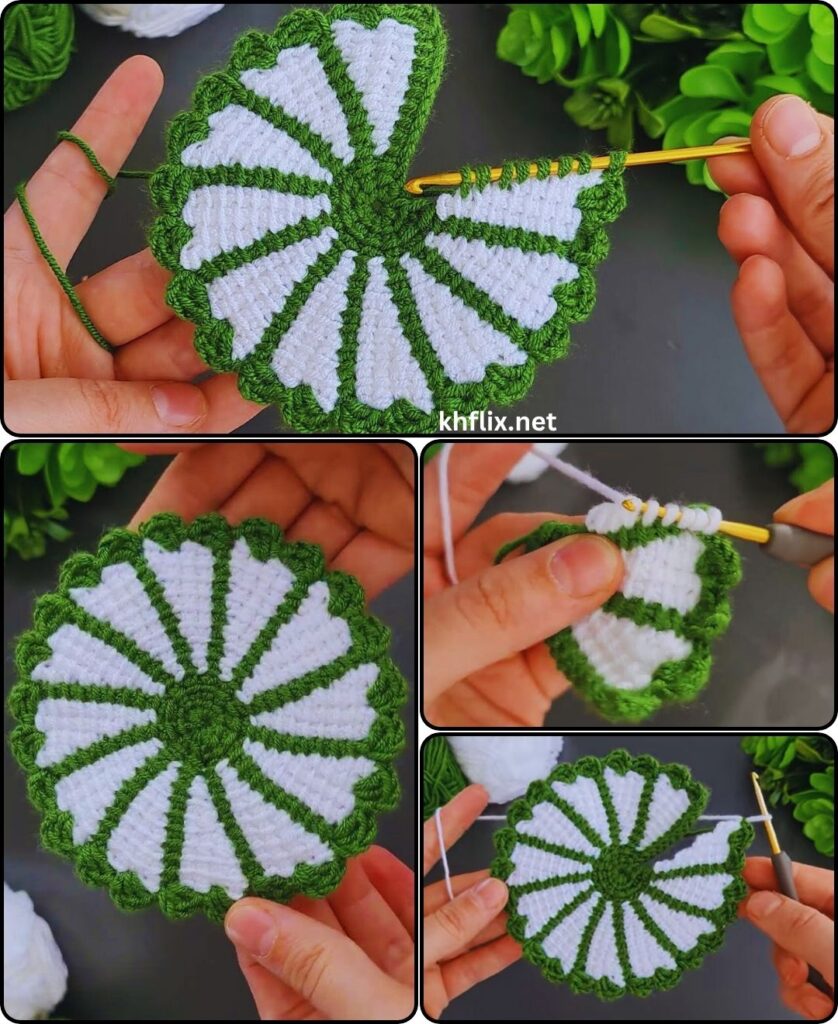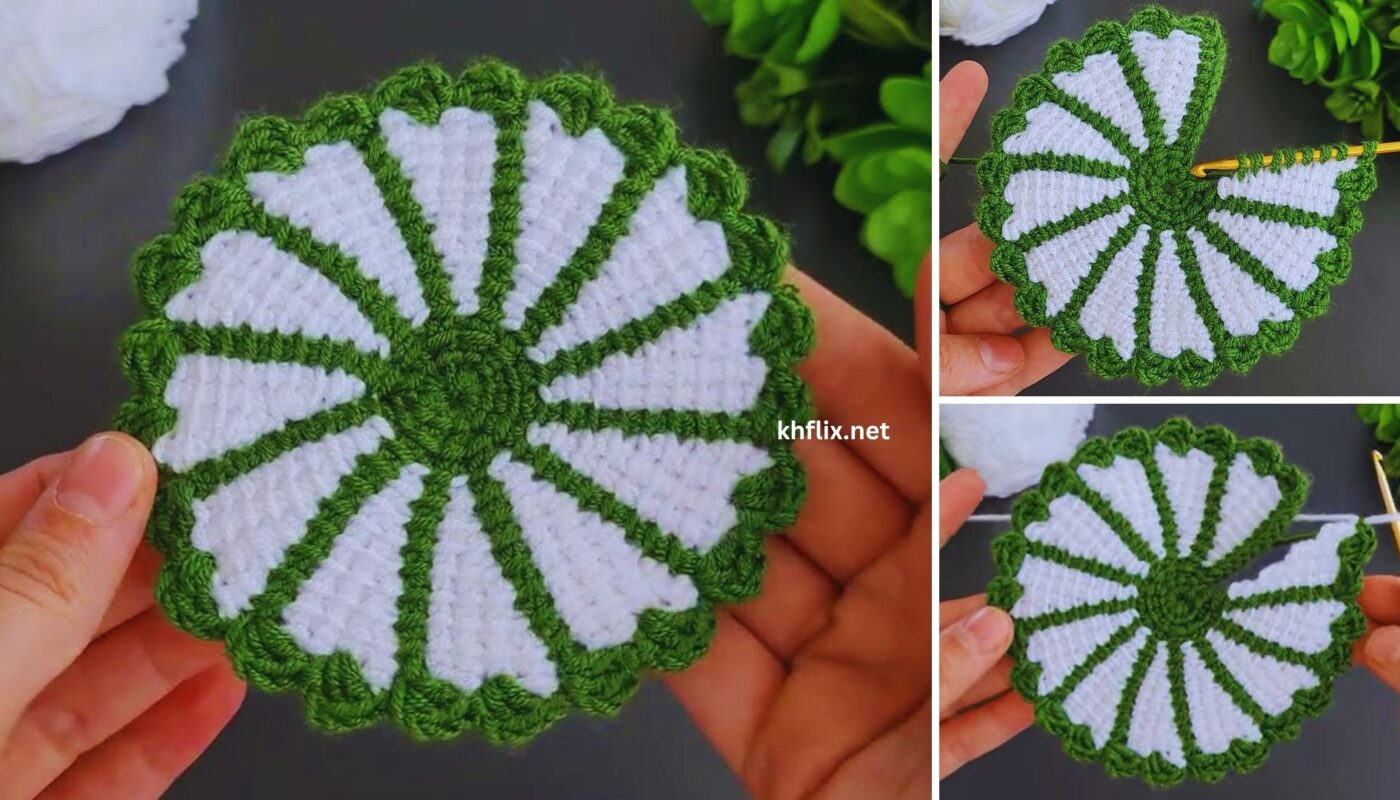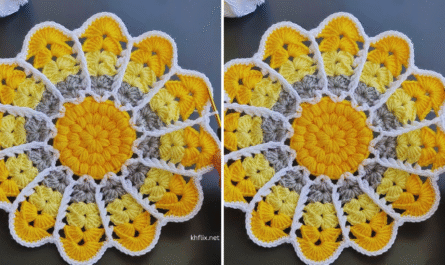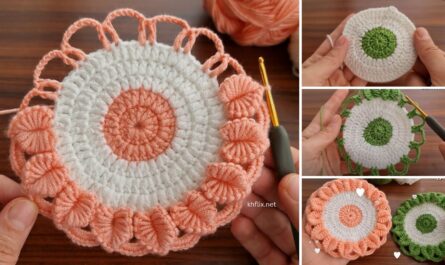You want to create a coaster supla motif with a striped design! This is an excellent choice for adding a pop of color and modern flair to your home decor. A circular shape with distinct stripes is particularly visually appealing.
This tutorial will guide you through crocheting a sturdy, flat, and vibrant circular coaster supla motif, emphasizing how to create clean and eye-catching stripes.

How To Crochet a Coaster Supla Motif (Striped Design)
This pattern creates a dense, flat circle using half double crochet (hdc) for a sturdy fabric, with consistent increases to maintain a flat shape, and strategic color changes for a bold striped effect.
Skill Level: Advanced Beginner / Intermediate
You should be comfortable with:
- Basic crochet stitches (ch, sl st, hdc).
- Working in the round.
- Understanding and executing increases for a flat circle.
- Performing clean color changes at the end of rounds.
Finished Motif Dimensions (Approximate):
- Diameter: 7-8 inches (18-20 cm)
Materials You’ll Need:
- Yarn:
- Worsted Weight (Medium #4) Cotton Yarn: Approximately 80-120 yards (73-110 meters) per motif. Cotton is highly recommended for mats due to its durability, absorbency, heat resistance, and ability to hold its shape well.
- Colors: Choose 2-3 contrasting or complementary colors for your stripes.
- Color A (Main Color)
- Color B (Accent Color 1)
- Color C (Accent Color 2 – Optional, for more varied stripes)
- Crochet Hook:
- Size H/5.0mm (or the hook size that gives you a firm, dense fabric that lies perfectly flat. Gauge is crucial here).
- Yarn Needle (Tapestry Needle): Essential for weaving in loose ends.
- Scissors
- Stitch Marker (Optional): Helpful for marking the beginning of rounds, especially when working in a spiral.
Gauge (Crucial for Flatness and Size!):
Maintaining a consistent gauge is vital to ensure your coaster supla lies perfectly flat without ruffling or cupping.
- After Round 4, your circle should measure approximately 4 inches (10 cm) in diameter.
- If your circle is smaller, try a larger hook. If it’s larger, try a smaller hook.
Abbreviations Used:
- ch: chain
- sl st: slip stitch
- hdc: half double crochet
- inc: increase (work 2 stitches into the same stitch)
- st(s): stitch(es)
- MR: Magic Ring (also known as Magic Circle or Adjustable Ring)
- FO: fasten off
Understanding Striped Design in the Round:
For a neat striped look in circular crochet, you’ll generally work in joined rounds (sl st to join at the end of each round, then ch up for the next). This ensures the color change happens in a consistent spot, making your stripes crisp.
How to Make a Clean Color Change:
- Work the last stitch of the round with the current color as normal, but stop when you have two loops left on your hook.
- Drop the current color.
- Pick up the new color, yarn over with the new color, and pull it through the remaining two loops on your hook to complete the stitch.
- You have now successfully changed colors. Sl st into the top of the initial stitch (or ch) of the round (with the new color) to join.
- Always cut the old color yarn, leaving a 4-6 inch tail to weave in securely later. For clean stripes, carrying yarn is generally not recommended as it can show through lighter colors or add bulk.

Let’s Start Crocheting Your Striped Coaster Supla Motif!
Part 1: Starting the Circle (Color A)
Option A: Magic Ring (Recommended for a tighter center)
- With Color A, make a Magic Ring (MR).
- Round 1: Ch 2 (does NOT count as a stitch). Work 10 hdc into the MR. Pull the tail tight to close the ring.
- Perform a clean color change to Color B. Sl st to the top of the first hdc to join. (Total: 10 hdc). Cut Color A, leaving a 4-inch tail to weave in.
Option B: Chain 4 Method (Alternative)
- With Color A, Ch 4, sl st into the 1st ch to form a ring.
- Round 1: Ch 2 (does NOT count as a stitch). Work 10 hdc into the ring.
- Perform a clean color change to Color B. Sl st to the top of the first hdc to join. (Total: 10 hdc). Cut Color A, leaving a 4-inch tail to weave in.
Part 2: Building the Striped Body (Color B, C, A, etc.)
We will continue working in joined rounds, making 10 increases in each round to keep the circle flat.
- Round 2 (Color B):
- With Color B, Ch 2 (does NOT count as a stitch). Work 2 hdc (inc) in the same st as join.
- Work 2 hdc (inc) in each of the next 9 hdc around. (Total 10 increases)
- Perform a clean color change to Color A. Sl st to the top of the first hdc to join. (Total: 20 hdc). Cut Color B, leaving a 4-inch tail.
- Round 3 (Color A):
- With Color A, Ch 2. Work 2 hdc (inc) in the same st as join.
- (Hdc in the next st, 2 hdc (inc) in the next st). Repeat from * to * 9 more times.
- Perform a clean color change to Color C (if using, otherwise back to Color B). Sl st to the top of the first hdc to join. (Total: 30 hdc). Cut Color A, leaving a 4-inch tail.
- Round 4 (Color C – Optional, otherwise Color B):
- With Color C, Ch 2. Work 2 hdc (inc) in the same st as join.
- (Hdc in each of the next 2 sts, 2 hdc (inc) in the next st). Repeat from * to * 9 more times.
- Perform a clean color change to Color A. Sl st to the top of the first hdc to join. (Total: 40 hdc). Cut Color C, leaving a 4-inch tail.
- Your circle should now be about 4 inches (10 cm) in diameter.
- Round 5 (Color A):
- With Color A, Ch 2. Work 2 hdc (inc) in the same st as join.
- (Hdc in each of the next 3 sts, 2 hdc (inc) in the next st). Repeat from * to * 9 more times.
- Perform a clean color change to Color B. Sl st to the top of the first hdc to join. (Total: 50 hdc). Cut Color A, leaving a 4-inch tail.
- Round 6 (Color B):
- With Color B, Ch 2. Work 2 hdc (inc) in the same st as join.
- (Hdc in each of the next 4 sts, 2 hdc (inc) in the next st). Repeat from * to * 9 more times.
- Perform a clean color change to Color C. Sl st to the top of the first hdc to join. (Total: 60 hdc). Cut Color B, leaving a 4-inch tail.
- Round 7 (Color C – Optional, otherwise Color A):
- With Color C, Ch 2. Work 2 hdc (inc) in the same st as join.
- (Hdc in each of the next 5 sts, 2 hdc (inc) in the next st). Repeat from * to * 9 more times.
- Perform a clean color change to Color A. Sl st to the top of the first hdc to join. (Total: 70 hdc). Cut Color C, leaving a 4-inch tail.
- Your circle should now be approximately 7-8 inches (18-20 cm) in diameter.

Part 3: Final Edge (Color A or your preferred last color)
This final round will give your coaster supla a very clean and firm edge.
- Round 8 (Optional Final Edge):
- With Color A, Ch 1 (does NOT count as a stitch). Sc in each hdc around.
- Sl st to the first sc to join.
- FO, leaving a 6-inch tail.
Part 4: Finishing & Blocking (Crucial for Flatness!)
- Weave in All Ends: This is essential for a clean, professional-looking motif, especially with multiple color changes. Thread each yarn tail onto your yarn needle. Carefully weave it through several stitches on the back side of your coaster supla, securing it invisibly. Take your time to ensure all tails are well-hidden and won’t unravel.
- Blocking: This step is crucial for any flat crochet piece, but especially for coaster suplaus, to ensure they lie perfectly flat and maintain their shape.
- Method: Gently wet your finished motif (either by misting with water or a quick dip and gentle squeeze – do not wring). Lay it perfectly flat on a blocking mat or a clean, dry towel. Gently stretch and pin the circle to its intended diameter, ensuring the edges are even. Allow it to air dry completely.
Your beautiful and sturdy circular striped crochet coaster supla motif is now complete! It’s a modern and functional accent for any surface in your home.
Customization Ideas:
- Stripe Widths: Change colors more or less frequently (e.g., every round, every 2 rounds, every 3 rounds) to create different stripe widths.
- Color Combinations: Experiment with different sets of colors – bold and contrasting, subtle and harmonious, or a rainbow effect!
- Size: To make a larger or smaller supla, simply add or remove repeat rounds from Part 2, maintaining the pattern of increasing by 10 hdc stitches per round (e.g., in Round 8, it would be “Hdc in each of the next 6 sts, 2 hdc (inc) in the next st” repeated 10 times, for a total of 80 hdc).
- Border: Instead of a simple sc edge, you could add a decorative border using shell stitches, picots, or reverse single crochet for a different look.




